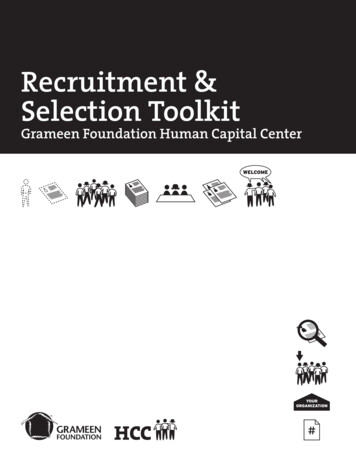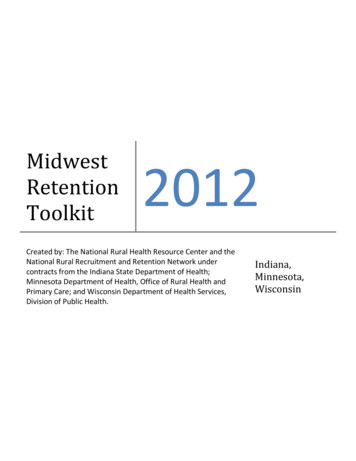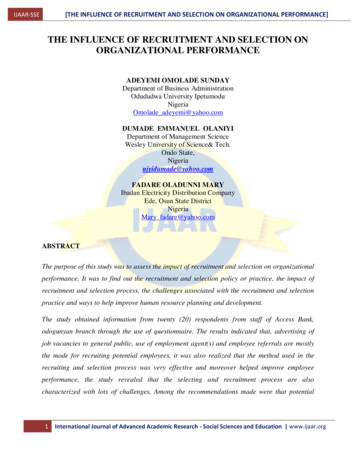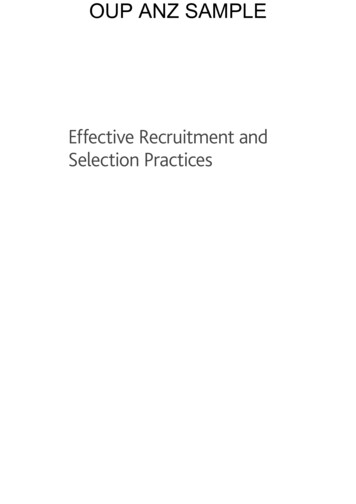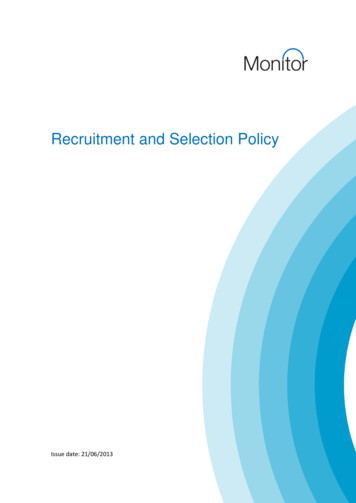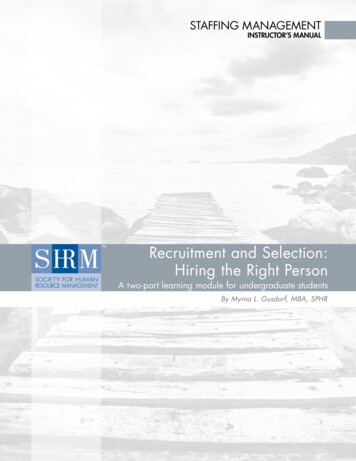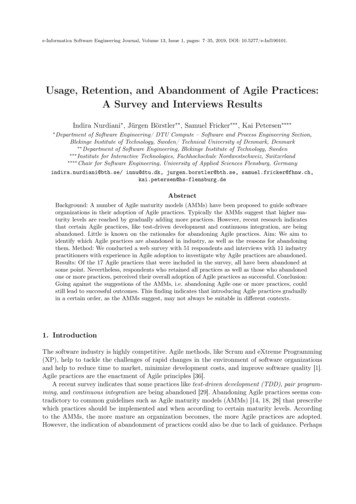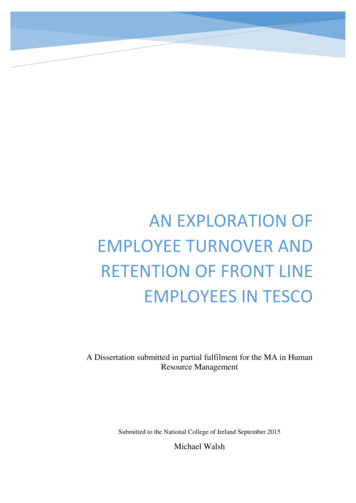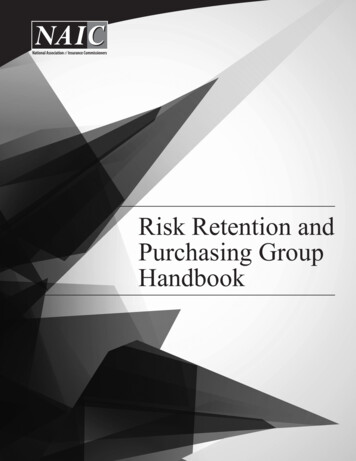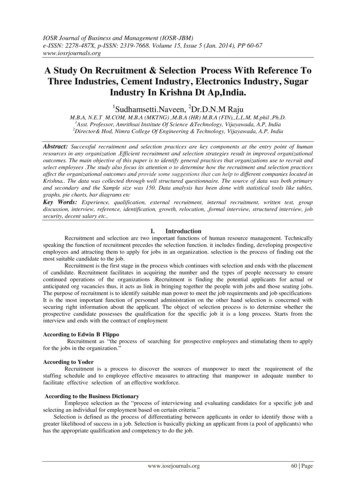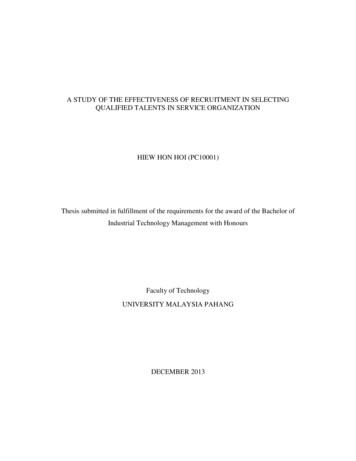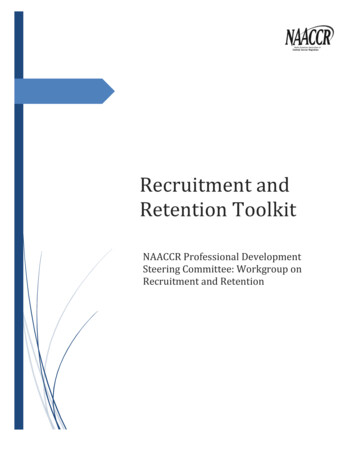
Transcription
Recruitment andRetention ToolkitNAACCR Professional DevelopmentSteering Committee: Workgroup onRecruitment and Retention
ACKNOWLEDGEMENTSThe NAACCR Professional Development Steering Committee would like to thank Stephanie Hill,Tresheena Boyd, and Taylor Hessler for acting as the primary authors of this document.Funding for this project was made possible in part by a cooperative agreement with Federal funds fromthe Centers for Disease Control and Prevention (CDC) Cooperative Agreement number 5NU58DP006458. Its contents are solely the responsibility of the authors and do not necessarilyrepresent the official views of the CDC.
NAACCR PROFESSIONAL DEVELOPMENT STEERING COMMITTEEMignon Dryden, CTR (Co-Chair)Cancer Registry of Greater CaliforniaStephanie Hill, MPH (Co-Chair)New Jersey State Cancer RegistryWendy Aldinger, RHIA CTRPennsylvania Cancer RegistryCarrie Bateman,Utah Cancer RegistryLynn Giljahn, MPHOhio Cancer Incidence Surveillance SystemLori Havener, CTRNorth American Association of Central Cancer RegistriesJim Hofferkamp, CTRNorth American Association of Central Cancer RegistriesAngela Martin,North American Association of Central Cancer RegistriesAngela Meisner, MPHNew Mexico Tumor RegistryDeirdre Rogers, Ph.D.Mississippi Cancer RegistryAndrea Sipin,Los Angeles Cancer Surveillance Program -USCHeather Stuart-Panko,Saskatchewan Cancer AgencyLori Swain,National Cancer Registrars Association3
BackgroundIn 2018, the NAACCR Professional Development Steering Committee conducted a survey of centralcancer registry directors in both the U.S. and Canada to identify the needs, barriers, and potentialsolutions to the recruitment and retention of registry operations staff. The survey was specific torecruitment of cancer registrar positions, including those holding the Certified Tumor Registrarcredential, as well as other staff involved in quality control activities.Central cancer registry directors were asked open-ended questions to identify the three biggest barriersin recruiting registry operations staff and to also share solutions. More specific questions were askedabout ability to offer a competitive salary, whether staff could work remotely, and recruitment andretention activities.One of the questions asked was how the NAACCR Professional Development Steering Committee couldhelp central registries with recruitment and retention. The most frequent responses were: collectingand sharing best practices and policies regarding recruitment/retention/working remotely; conducting asalary survey; and providing a platform for sharing related information.The NAACCR Professional Development Steering Committee developed a small workgroup to develop arecruitment and retention toolkit based on practices collected from central cancer registries and otherorganizations.OverviewThe purpose of the NAACCR Recruitment and Retention Toolkit is to provide central cancer registries(CCRs) with proven strategies for attracting and retaining qualified staff. The Toolkit was developed bythe NAACCR Professional Development Steering Committee from best practices submitted by CCRsthroughout North America. Every CCR is unique, with its own recruitment and retention challenges.Consequently, no one strategy will suit the needs of every CCR, so the NAACCR R&R Toolkit contains avariety of resources to choose from and customize to meet the specific needs of the registry.ToolkitThe Toolkit is organized into two primary sections: Recruitment and Retention. Each section is furtherdivided into tools for specific topics:RecruitmentThe Toolkit aims to address two major recruitment barriers identified by the NAACCR Recruitment andRetention Survey: a lack of CTRs and a lack of interested applicants for central registry jobs. The Toolkitalso includes broader recruitment resources based on the principle that retention begins with recruitingthe right candidates. Not everyone has what it takes to succeed in the central cancer registry setting.The recruitment section of the Toolkit focuses not only on attracting candidates – but attracting theright candidates. We provide sample language and templates for job descriptions, tips for job postingsand screening applicants and interview strategies. For central registries experiencing a shortage of CTRs,the Toolkit includes resources for identifying and training candidates to become CTRs.4
ToolJob Description TemplatesDescriptionCustomizable templates based on job descriptions from severalregistries. Plug in language from the Job Description Builder orcreate your own.Guidance for Job PostingsIf you have the ability to draft your own job postings, use these tipsto attract qualified candidates.Recruitment FlyerA customizable flyer highlighting the many benefits of working in acentral cancer registry. Use the flyer as is or add your own logo andunique attributes of your registry.Job Posting ResourcesA listing of online options for advertising job openings.Pre-Interview ApplicantEvaluationUse this tool to prioritize which candidates to interview based onminimum and preferred qualifications.Applicant FAQMeant to be provided to the candidates when you have too manyapplicants to interview and need to screen out those who may notbe right for the position. Customize the questions to meet yourregistry’s needs.Applicant TestsMini-exams to assess an applicant’s knowledge, from anatomy andphysiology and medical terminology to cancer registry codingprinciples.Interview StrategiesBest practices for use before, during and after the interview.Sample Interview QuestionsExamples of questions to ask during the interview.Candidate Score SheetUse to objectively evaluate and compare candidates based on a setof pre-defined criteria.Growing a CTR – Choosingthe Right CandidateResources for identifying and attracting non-CTRs for training.Student Visit Procedure andAgenda TemplatesA best practice to orient cancer registry students to the centralregistry and generate interest in applying for central registrypositions.Training ResourcesTools successfully used by registries to prepare new employees tobecome CTRs.RetentionThe NAACCR Recruitment and Retention Survey identified several barriers to retention, including noncompetitive salaries, lack of promotional opportunities, and lack of job flexibility (i.e., workingremotely). While some barriers are beyond the control of central registries, the workgroup identifiedpractices used by some registries to successfully retain staff despite these barriers.5
ToolCreating EngagedEmployeesDescriptionEngaged employees are more likely to remain in a job. Use thesetips to increase engagement among central registry staff.Functional Job DescriptionsWhen generic job descriptions don’t match day-to-day job duties,expectations can be unclear for both the employee and themanager. Functional job descriptions can help clarify expectationsand lead to success.Retention InterviewsRegular one-on-one discussions with staff can help identify andaddress issues before they lead to a resignation and can allow youto personalize retention strategies.Exit InterviewsWhen someone does resign, an exit interview can help identify rootcauses and improve practices.Other ConsiderationsThere are some factors affecting central registry recruitment and retention, such as salary and workflexibility, that are beyond the control of the registry. The NAACCR Professional Development SteeringCommittee should continue to explore resources to assist central registries in advocating for change,including conducting a survey of central registry salaries and developing telecommuting best practices.6
salary survey; and providing a platform for sharing related information. The NAACCR Professional Development Steering Committee developed a small workgroup to develop a recruitment and retention toolkit based on practices collecte

